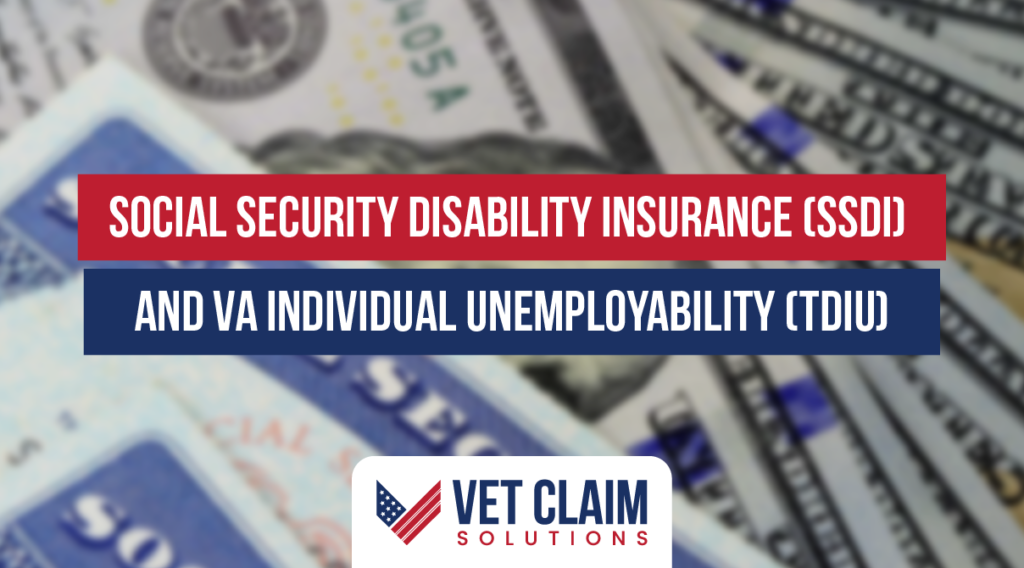Receiving disability benefits can make a significant difference in the financial and medical support one receives. Two common programs that provide such assistance are Total Disability Individual Unemployability (TDIU) and Social Security Disability Insurance (SSDI). But can you qualify for both? Many individuals may wonder whether it is possible to receive benefits from both programs simultaneously. This article will explore the eligibility criteria and the conditions under which one can receive both TDIU and SSDI benefits. Understanding these guidelines can help individuals navigate the intricacies of these programs and secure the maximum assistance they are entitled to.
What is SSDI, and who qualifies?

SSDI, or Social Security Disability Insurance, is a crucial federal program designed to provide financial support to individuals who have become disabled and cannot work due to their disability. The Social Security Administration (SSA) manages the program and is funded through payroll taxes paid by eligible workers.
The primary purpose of SSDI is to replace a portion of the income a worker loses due to a significant and long-term disability. It acts as a safety net, offering financial stability to those who find themselves in unfortunate circumstances and can no longer engage in substantial gainful activity due to their Disability.
Eligibility for SSDI
Eligibility for SSDI is determined based on a combination of factors. Firstly, the individual must have worked jobs covered by Social Security and paid Social Security taxes. They must have accumulated enough work credits over time to be considered “insured” under the program. The number of work credits required will depend on the individual’s age when they became disabled.

You must have accumulated enough work credits over time to qualify for SSDI.
Secondly, to qualify for SSDI benefits, the individual must have a “total” disability, meaning their condition must be severe enough to prevent them from performing any substantial gainful activity (SGA). The SSA has specific criteria that define what constitutes a disabling condition, and it maintains a list of severe impairments known as the “Blue Book.” If an individual’s medical condition matches or is equivalent to a listed impairment, they are eligible for SSDI.
What is Total Disability Based on Individual Unemployability (TDIU)?
Total Disability Based on Individual Unemployability (TDIU) is a critical provision offered by the U.S. Department of Veterans Affairs (VA) to support disabled veterans who cannot maintain or obtain substantially gainful employment due to their service-connected disabilities. TDIU ensures that these veterans receive compensation at the total disability rate, even if their service-connected Disability is rated at less than 100 percent.

The primary criterion for qualifying for TDIU is the inability to engage in substantially gainful employment. The VA defines “substantially gainful” as employment that enables a disabled veteran to earn an income comparable to that of a non-disabled person in a similar occupation and location. In determining gainful employment, the VA considers the veteran’s income in relation to the poverty threshold, which is $12,880 for a single-family in 2021. If the veteran’s income falls below this threshold, their work will not be considered substantially gainful. If their income is slightly above the poverty threshold, the VA will make an individualized determination based on the specific circumstances.

Age is not a factor when assessing eligibility for TDIU. Even retirement-aged veterans may qualify if their service-connected Disability prevents them from substantially gainful employment.
Eligibility for TDIU:
To be eligible for TDIU, veterans must meet specific disability rating requirements. They should have either:

A single service-connected disability with a 60 percent or higher rating.

Multiple service-connected disabilities with a combined rating of at least 70 percent, with at least one Disability at 40 percent or higher.
It is essential for veterans seeking TDIU to provide comprehensive documentation of their employment situation and disability rating. By meeting these criteria, veterans will qualify for this significant benefit.
TDIU is designed to alleviate financial burdens for disabled veterans who cannot work due to their service-related disabilities. By providing compensation at the total disability rate, the VA aims to support these veterans in maintaining a reasonable quality of life despite their physical or mental limitations.
What’s the difference between SSDI and Individual Unemployability (TDIU)?
1. Administering Agencies:

SSDI: Social Security Administration (SSA)

TDIU: U.S. Department of Veterans Affairs (VA)
2. Eligibility Criteria:

SSDI: Based on having a qualifying disability and sufficient work credits through paying Social Security taxes.

TDIU: Available to disabled veterans with service-connected disabilities who cannot maintain or obtain substantially gainful employment.
3. Recipients:

SSDI: Available to individuals with disabilities who have paid into Social Security.

TDIU: Exclusively for disabled veterans with service-connected disabilities.
4. Disability Rating:

SSDI: Disability severity is not rated; eligibility is based on SSA’s definition of Disability.

TDIU: Requires a specific disability rating for eligibility (60% or higher for a single disability or a combined rating of 70% with at least one Disability rated at 40% or higher).
5. Benefit Calculation:

SSDI: Benefits are based on the individual’s work history and previous earnings.

TDIU: Provides compensation at the total disability rate for disabled veterans.
6. Medical Condition:

SSDI: Disability can be any severe condition that meets the SSA’s definition.

TDIU: Disability must be service-connected, resulting from military service.
7. Medicare Eligibility:

SSDI: Recipients may become eligible for Medicare after a waiting period.

TDIU: Medicare eligibility is not directly tied to TDIU benefits; veterans have separate healthcare options through the VA.
Can a Veteran Receive Both TDIU and SSDI?
Veterans can receive both TDIU and SSDI benefits if they qualify for both programs. Meeting the eligibility criteria for each program independently allows veterans to access additional financial support to cover medical and living expenses.
FAQs
1. What is Social Security Disability Insurance (SSDI)?
Social Security Disability Insurance (SSDI) is a federal program administered by the Social Security Administration (SSA) that provides monthly benefits to individuals with disabilities who are unable to work.
2. How do I qualify for SSDI benefits?
To qualify for SSDI benefits, you must meet specific criteria set by the SSA. These criteria include having a disability that prevents you from performing a substantial gainful activity (SGA), earning enough work credits through paying Social Security taxes, and meeting the SSA’s definition of Disability.
3. What is the definition of Disability according to the SSA?
According to the SSA, Disability is the inability to engage in substantial gainful activity (SGA) due to a medically determinable physical or mental impairment that is expected to last for at least 12 months or result in death.
4. Can I receive SSDI benefits and VA Individual Unemployability (TDIU) at the same time?
Yes, it is possible to receive SSDI benefits and VA Individual Unemployability (TDIU) simultaneously. However, accepting TDIU benefits may affect the amount of your SSDI benefits.
5. What is VA Individual Unemployability (TDIU)?
VA Individual Unemployability (TDIU) is a benefit provided by the Department of Veterans Affairs (VA). It allows veterans with service-connected disabilities to receive compensation at the 100% disability rate, even if their combined rating does not reach 100%.
6. What is the difference between TDIU and SSDI?
The main difference between TDIU and SSDI is that TDIU is a benefit provided by the VA for veterans with service-connected disabilities. At the same time, SSDI is a federal program administered by the SSA for individuals with disabilities who have earned enough work credits. Additionally, the eligibility criteria and application processes for TDIU and SSDI are different.
7. Can I apply for TDIU and SSDI at the same time?
Yes, you can apply for TDIU and SSDI at the same time. However, the eligibility criteria for TDIU and SSDI are different, and the approval of one benefit does not guarantee the approval of the other.
8. Can I receive VA disability benefits and SSDI benefits at the same time?
Yes, it is possible to receive VA disability benefits and SSDI benefits at the same time. These benefits are separate programs, and receiving one does not affect your eligibility for the other.
9. What is the difference between VA disability benefits and SSDI benefits?
The main difference between VA disability benefits and SSDI benefits is that VA disability benefits are provided by the VA for veterans with service-connected disabilities, while SSDI benefits are provided by the SSA for individuals with disabilities who have earned enough work credits. The eligibility criteria and application processes for these benefits are also different.
10. What is the process for filing a TDIU claim?
The process for filing a TDIU claim involves submitting a completed application to the VA along with supporting documentation, such as medical records and evidence of your service-connected disabilities. It is recommended to seek assistance from a veterans law attorney or a veterans service organization to ensure that your claim is properly prepared and presented.
Have Questions About Your VA Claim?
If you have questions about your VA claim, VetClaim Solutions is here to help. Our team of experienced VA coaches can provide guidance and support throughout the claims process. Whether you need assistance with filing a new claim, gathering evidence, or understanding the appeals process, our knowledgeable coaches are here to answer your questions and help you navigate the VA system.


